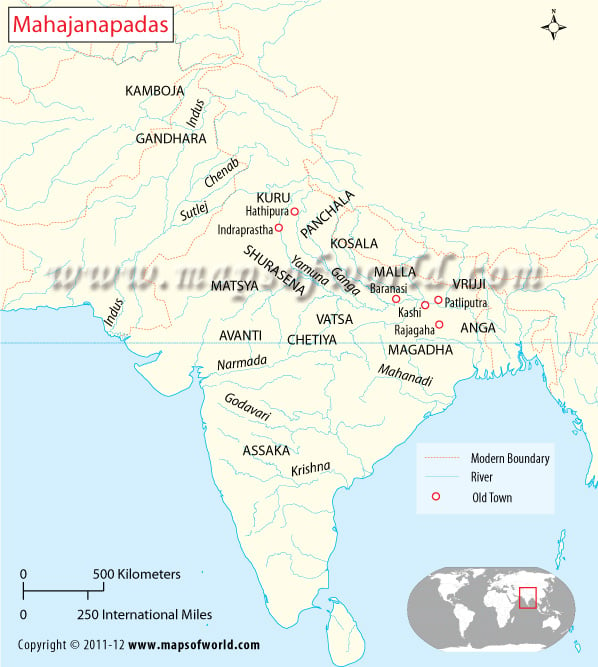Toward the end of the Vedic Period in India, sixteen powerful states or kingdoms had emerged all over north, northwestern, and eastern India.
These sixteen kingdoms were known as the Mahajanapadas. Though historical records show that the existence of many of these kingdoms goes as far back as 1000 BC, the Mahajanapadas gained prominence around 600 BC.
The Sixteen States
Kamboja – With its capital at Rajpura in modern-day Kashmir, the kingdom of Kamboja spanned across the Hindu Kush Mountains to the southwest of Kashmir.
Gandhara – The land of Gandhara was to the northwestern fringe of the Indian subcontinent, covering areas of modern day Afghanistan and Pakistan. Taxila, the great center for learning, was the capital of Gandhara.
Kuru – The Kuru kingdom covered present-day Delhi and the Indian state of Haryana. Hastinapura, its capital, was abandoned in favor of Indraprastha. The Mahabharata centers on the ruling dynasty of Kuru.
Panchala – Panchala, in the fertile Gangetic Valley of Uttar Pradesh, was ruled by two capitals – Ahichhatra and Kampilya. The city of Kanauj in Panchala became a center for higher studies, art, culture, and political clout.
Kosala – Governed by the capital city of Sravasti, Kosala was the kingdom locked between the Himalayas to the north and the Ganges to the south. The city of Ayodhya also served as the capital, and the epic Ramayana was set to the life of Ayodhya’s prince, Rama.
Malla – Malla, to the east of modern-day Uttar Pradesh, finds mention in Jain and Buddhist texts. Malla was among the earliest kingdoms of India to adopt the republic form of government. Pava and Kusinara seem to have been the most important cities of Malla.
Matsya – The kingdom of Matsya encompasses modern-day Rajasthan including cities such as Jaipur, Bharatpur, and Alwar. The capital, Viratnagar, was named after the renowned Matsya king, Virata.
Vriji – Vriji was a confederation of nine clans. Among these, the Licchhavis were most prominent. The capital of Vriji was Vaishali, and the kingdom covered parts of modern-day Bihar and Uttar Praesh.
Kashi – The kingdom of Kashi was the most sacred and powerful among the Mahajanapadas before the time of Buddha. With its capital at Varanasi, Kashi was a favorite pilgrimage destination of the ancient Indians.
Vatsa – The kingdom of Vatsa, with its capital at Kausumbi, centered on modern-day Allahabad.
Avanti – The kingdom of Avanti in central India had its capital in Ujjain. Ujjain later became famous for the wise King Vikramaditya and for the Temple of Shiva located there.
Chedi – Lying between Vatsa and Kuru and on the banks of River Narmada, the kingdom of Chedi was governed from Suktimati. Another branch of the Chedi lineage is known to have governed parts of Nepal.
Magadha – The kingdom of Magadha was located in the southern regions of Bihar and the western parts of Bengal. Buddhism spread in the land under the patronage of King Bimbisara and King Ajatasatru. The capital, Rajagriha, was later moved to Pataliputra.
Anga – Anga in southern Bihar had its capital at Champa. The state was annexed by Magadha King Bindusara.
Assaka – Assaka was the southern-most of the sixteen Mahajanapada states and was located in modern-day Maharashtra. Its capital, Potana, was a great center for learning.
Surasena – Surasena, on the western bank of the Yamuna River, had its capital at Mathura. Mathura was a stronghold of the Yadava clan, and the Yadava King of Mathura, Krishna, is worshipped as God incarnate.
By 500 BC, four of the sixteen Mahajanapada states had gained prominence and had annexed the others. Magadha, Kosala, Avanti, and Vatsa remained the seats of political power in northern India. Though Sanskrit was still the language of the elite, the masses spoke in various dialects of Prakrit.
Canaanite Religion
The discovery of the Ras Shamra tablets in 1928 brought to light much of what is known about the Canaanite religion. Like most pagan religions, the Canaanite religion idolized forces of nature. El and Baal were the main deities. El was the lord of rainfall and Baal caused the earth to be fertile. Other major deities of the Canaanite religion were Kothar, Asherah, Resheph, and Astarte.
Early Alphabet
The use of the alphabet was pioneered by the Canaanites. The language of Canaan was the earliest form of Hebrew. While the use of Phoenician and cuneiform was not unknown in ancient Canaan, the Canaanites are known to have devised their own form of writing which later evolved into Hebrew.

